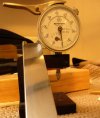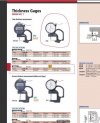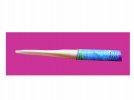-
The BladeForums.com 2024 Traditional Knife is ready to order! See this thread for details: https://www.bladeforums.com/threads/bladeforums-2024-traditional-knife.2003187/
Price is$300$250 ea (shipped within CONUS). If you live outside the US, I will contact you after your order for extra shipping charges.
Order here: https://www.bladeforums.com/help/2024-traditional/ - Order as many as you like, we have plenty.
You are using an out of date browser. It may not display this or other websites correctly.
You should upgrade or use an alternative browser.
You should upgrade or use an alternative browser.
terms and spelling: thickness gague (gage) or dial indicator
- Thread starter annr
- Start date
yablanowitz
Platinum Member
- Joined
- Apr 14, 2006
- Messages
- 9,913
Gauge and gage are both correct spellings for the same word (don't you just love English?) although gauge is more commonly seen. A dial caliper is a thickness gauge, but not all thickness gages are dial calipers. Micrometers and vernier calipers are thickness gauges as well.
annr
Basic Member
- Joined
- Nov 15, 2006
- Messages
- 9,813
Gauge and gage are both correct spellings for the same word (don't you just love English?) although gauge is more commonly seen. A dial caliper is a thickness gauge, but not all thickness gages are dial calipers. Micrometers and vernier calipers are thickness gauges as well.
Right, my subject matter requires steel rulers, vernier calipers, micrometers and thickness gauges (dial indicator) which I've been calling 'dial indicator thickness gauges' to avoid confusion.
I had started with gauge. I'm reading "Inspection and Gaging", which always uses gage. My dictionary show gage as a variant used for nautical.
I am putting together a style sheet (need to unify 10 documents) so I want to make as easy on the reader as possible.
yablanowitz
Platinum Member
- Joined
- Apr 14, 2006
- Messages
- 9,913
Yes, I learned the "gage" spelling while I was in the Navy many years ago, and I've been using them interchangably since then. I would suggest using "gauge" exclusively as the more common spelling is less likely to be misunderstood at a glance. These days, you can't assume that someone reading your work won't mistake "gaging" for "gagging". 
annr
Basic Member
- Joined
- Nov 15, 2006
- Messages
- 9,813
Yes, I learned the "gage" spelling while I was in the Navy many years ago, and I've been using them interchangably since then. I would suggest using "gauge" exclusively as the more common spelling is less likely to be misunderstood at a glance. These days, you can't assume that someone reading your work won't mistake "gaging" for "gagging".
You are so right about how words trick people. I lived with a Korean roommate who told everyone she was a magician (should be musician). Another friend, non-English speaker, confuses kitchen and chicken. I certainly don't want encourage any :barf: ing; would put a whole new meaning on things, sounds like some kind of anorexic fettish
Anyway, I had never seen gage before I read the book I mentioned; it has no link to nautical from what I see so I thought I would put out feelers. Seems like I found the right guy.
I do like spelling gage much better. I must have mistyped and misspelled gauge at least 99% of the time; still do. Thanks.
Hi,
To add to the confusion of gauge vs. gage.
When I was in school, way back when, learning to be a machinist, we were taught that a gage is a fixed measuring device. Like gage blocks or go-no go gages.
A gauge is a variable measuring device like a micrometer or pressure gauges.
But I think time has blurred the distinction between the two words. Both are used interchangeably today to mean the same thing. So don't sweat it. Just try to be consistent in which word you choose to use.
One correction for you. A dial indicator is NOT a way to measure thickness. It is, as the name imply's, an indicator of differences. It can provide no direct absolute measurement by itself. This is why it's always "zeroed" against a predetermined measurement, (a gage ) before use.
) before use.
dalee
To add to the confusion of gauge vs. gage.
When I was in school, way back when, learning to be a machinist, we were taught that a gage is a fixed measuring device. Like gage blocks or go-no go gages.
A gauge is a variable measuring device like a micrometer or pressure gauges.
But I think time has blurred the distinction between the two words. Both are used interchangeably today to mean the same thing. So don't sweat it. Just try to be consistent in which word you choose to use.
One correction for you. A dial indicator is NOT a way to measure thickness. It is, as the name imply's, an indicator of differences. It can provide no direct absolute measurement by itself. This is why it's always "zeroed" against a predetermined measurement, (a gage
dalee
annr
Basic Member
- Joined
- Nov 15, 2006
- Messages
- 9,813
Hi,
One correction for you. A dial indicator is NOT a way to measure thickness. It is, as the name imply's, an indicator of differences. It can provide no direct absolute measurement by itself. This is why it's always "zeroed" against a predetermined measurement, (a gage) before use.
dalee
Thanks,
Yes, I am confused and not even sure that I've accurately told you what I'm trying to ask about. I am attaching a picture. Would you mind taking a look and telling me what the best word(s) are to name this?
annr
Attachments
Last edited:
Hi,
Your picture is of a comparator gauge. Often referred to as a "snap" gauge because of the sound it makes when you use it. It's normally used to quickly verify thickness of materials for tolerancing purposes. They come in a wide variety of shapes and sizes.
Your Mitutoyo indicator is a good one. Has a range of .500" with graduations of .001". The bottom round looking anvil looks like was meant more for checking tubing wall thickness. Rather than flat sections. While it could be used to check flat pieces, there would be a risk of rolling the part and changing the results.
You would use it by first inserting a standard gage of known thickness. You would then set the dial pointer to zero. Then you can quickly compare the rest of your parts to the standard to see if they were made correctly. The ring on the outside of the indicator dial often has two little metal pointers that can be slide around the rim to show a range. When the pointer falls within the two little metal pointers, the part would be in tolerance.
You do see these used in high volume manufacturing setting. And generally they are purpose built fixtures to check a specific part. But these aren't something you would normally find in machinist's tool box.
dalee
Your picture is of a comparator gauge. Often referred to as a "snap" gauge because of the sound it makes when you use it. It's normally used to quickly verify thickness of materials for tolerancing purposes. They come in a wide variety of shapes and sizes.
Your Mitutoyo indicator is a good one. Has a range of .500" with graduations of .001". The bottom round looking anvil looks like was meant more for checking tubing wall thickness. Rather than flat sections. While it could be used to check flat pieces, there would be a risk of rolling the part and changing the results.
You would use it by first inserting a standard gage of known thickness. You would then set the dial pointer to zero. Then you can quickly compare the rest of your parts to the standard to see if they were made correctly. The ring on the outside of the indicator dial often has two little metal pointers that can be slide around the rim to show a range. When the pointer falls within the two little metal pointers, the part would be in tolerance.
You do see these used in high volume manufacturing setting. And generally they are purpose built fixtures to check a specific part. But these aren't something you would normally find in machinist's tool box.
dalee
annr
Basic Member
- Joined
- Nov 15, 2006
- Messages
- 9,813
Hi,
Your picture is of a comparator gauge. Often referred to as a "snap" gauge because of the sound it makes when you use it. It's normally used to quickly verify thickness of materials for tolerancing purposes. They come in a wide variety of shapes and sizes.
Your Mitutoyo indicator is a good one. Has a range of .500" with graduations of .001". The bottom round looking anvil looks like was meant more for checking tubing wall thickness. Rather than flat sections. While it could be used to check flat pieces, there would be a risk of rolling the part and changing the results.
You would use it by first inserting a standard gage of known thickness. You would then set the dial pointer to zero. Then you can quickly compare the rest of your parts to the standard to see if they were made correctly. The ring on the outside of the indicator dial often has two little metal pointers that can be slide around the rim to show a range. When the pointer falls within the two little metal pointers, the part would be in tolerance.
You do see these used in high volume manufacturing setting. And generally they are purpose built fixtures to check a specific part. But these aren't something you would normally find in machinist's tool box.
dalee
Fascinating. Thanks. You are right- this is a specialty item and currently goes for $250-$275, probably over-priced?
Basically I use it to screen material that needs to fall between .58-.60 mm. We buy these little gadgets and watch the indicator go from 0 to .58 mm or some other number. Who knew? I attached a little illustration showing the profile of the item (black line=.58-.60mm). The bottom side of the piece is hard bark, the upper side is very soft, pithy and easily crushed (it's cane).
This gauge is supposed to be able to check tube walling of a sort, though I can't rationalize that it is accurate because I haven't figured out a way to hold the piece (picture with pink background) without influencing the reading.
The anvil goes into a tiny, oval opening at the left side, (about 1mm wide at most). The piece varies from .001mm-.60mm in thickness depending on where you measure (verified in autopsy, after dismantling
Would it be accurate to call it a 'dial indicator'? Or not inaccurate? (more people in my field will know what that is.)
annr
Last edited:
Hi,
I see were it would work well for the things you're checking with it. It's quick and accurate enough to sort the bad parts from the good with very little fuss.
I'd probably need to see it to figure out how it measures tubing. I was just going by the round anvil under the point. Which is pretty common to tubing measuring tools.
The whole unit is a comparator. The dial indicator is the gauge that is removable and replaceable. And is a separate part. I own almost a dozen dial indicators of different types that I can configure into different devices as I need them.
As far as cost goes, I've got dial indicators alone that cost over $100 each. So $200 for a dial indicator and fixture isn't bad at all. You get what you pay for.
dalee
I see were it would work well for the things you're checking with it. It's quick and accurate enough to sort the bad parts from the good with very little fuss.
I'd probably need to see it to figure out how it measures tubing. I was just going by the round anvil under the point. Which is pretty common to tubing measuring tools.
The whole unit is a comparator. The dial indicator is the gauge that is removable and replaceable. And is a separate part. I own almost a dozen dial indicators of different types that I can configure into different devices as I need them.
As far as cost goes, I've got dial indicators alone that cost over $100 each. So $200 for a dial indicator and fixture isn't bad at all. You get what you pay for.
dalee
annr
Basic Member
- Joined
- Nov 15, 2006
- Messages
- 9,813
The dial indicator is the gauge that is removable and replaceable. And is a separate part. I own almost a dozen dial indicators of different types that I can configure into different devices as I need them.
Hi,
This was where I was stuck.
After that I took a more careful look, I see it has a continuous dial. Evidently it has direct reading capabilities - and certainly that is how it is used.
I agree that you get what you pay for, but I have trouble getting folks to lay out $280. Too bad for them, they waste a lot of time with garbage materials.
Thanks for your help.
annr
shunsui
Gold Member
- Joined
- Aug 12, 2008
- Messages
- 5,796
annr
Basic Member
- Joined
- Nov 15, 2006
- Messages
- 9,813
Thanks. This was very helpful. Evidently I was correct, although I still haven't decided on the wording--to keep it simple.
This is a dial indicator and a thickness gage, thickness gage being a variety of dial indicator.
If gage is good enough for them I'll go with it!
I can see now that mine is a customized product. I don't know how difficult or expensive it would be to purchase directly, but this is good to know.
Last Visible Canary
actively parsing hurf durf
- Joined
- Nov 28, 2006
- Messages
- 4,577
Gauge and gage are both correct spellings for the same word (don't you just love English?) although gauge is more commonly seen. A dial caliper is a thickness gauge, but not all thickness gages are dial calipers. Micrometers and vernier calipers are thickness gauges as well.
it's kinda funny, I was going to say that a gauge is a measuring instrument and a gage is a gauntlet used to initiate a dual, but I remember reading 'go-no-go gage' in my text book and it is in fact spelled gage. Apparently gage is a machinist specific spelling that is not utilized throughout the rest of the english language as a term for measurement. In this case I would assume that 'gauge' is a generic term for the act of measuring something, where 'gage' in the machinist sense is a tool used to measure.
I tend to think of thickness gauges as being something that touches both sides of an object, where a dial indicator is used to determine a distance from a flat surface to a feature, or the variation from one part of a surface to another (independent of actual distance from resting surface to feature) such as when your calibrating the perpendicularity of your chuck or mill table.
so, I'd say that in use, never use gage to describe someone measuring something, only use it to describe the tool they are using to measure with. If you know the industry specific spelling, such as 'tire gauge' default to it, when referring to machinists tools, default to gage.
edit: it may be appropriate to use the term "he is gaging the material now" to describe the use of a gage, rather than the act of measurement.
annr
Basic Member
- Joined
- Nov 15, 2006
- Messages
- 9,813
i
edit: it may be appropriate to use the term "he is gaging the material now" to describe the use of a gage, rather than the act of measurement.
You would be correct. :thumbup:That is how this whole thing got rolling around in my head: I'm reading Inspection and Gaging. In the book the act of using gages is gaging, new to me.
I agree that gauging is probably for more non-technical situations, "That would be tough to gauge."
Here is what I found in the catalog- in the dial indicator section
(BTW--I don't see how this "tube thickness" measurement is accurate since the reed can easily push back against the spring.)
Thanks.
Attachments
Last Visible Canary
actively parsing hurf durf
- Joined
- Nov 28, 2006
- Messages
- 4,577
Here is what I found in the catalog- in the dial indicator sectionThese are the items I'm measuring. Do they match your idea? The cane sits between the anvil and spindle's contact point, OR the anvil is inserted into the reed to gage
thickness.
absolutely. I don't know the specific definition for that, but I beleive it would be described as a 'continuous-reading dial indicator' held in a jig that allows for thickness to be 'gaged'
I was thinking 'universal dial test indicator' when I said it is used to test variances in the height of surface features when measuring from a flat surface.
it's been a looong time since I've taken a machining class, and the only metrology I do is on opthalmic optics, like this 'geneva lens clock':

as soon as the welding portion of my a.s. is done I hope to get back into machining classes to learn more about metrology.
annr
Basic Member
- Joined
- Nov 15, 2006
- Messages
- 9,813
absolutely. I don't know the specific definition for that, but I beleive it would be described as a 'continuous-reading dial indicator' held in a jig that allows for thickness to be 'gaged'p) from a set point.
Yes, professor. :thumbup: Believe it or not I followed you! (You see I am a professional classical musician, if you want to talk about a handicap
In my reference book they distinguish between the balanced dials and continuous dials. Your little +/- signs would seem to put your gage in the balanced side and mine in the other. Evidently, another clue would be the revolution counter on mine, since this is taking a direct measurement.
It is a mouthful saying what mine is and isn't--giving me a headache. I'll probably cover the whole enchilada in the section on measuring and tools-- give the mouthful. After that I'm thinking of sticking with thickness gage and gage. If readers do their homework I think that they will appreciate gage rather than some long string of words. (I bet German has just the word for this--only 50 characters long.
Your job sounds interesting!
Thanks for the pic, helps.
Last Visible Canary
actively parsing hurf durf
- Joined
- Nov 28, 2006
- Messages
- 4,577
The lens clock is used to measure diopters of curvature, with the 180 degree line being 0.00D (totally flat). (+) is for convex, and (-) for concave, as an example the front of the human is +6.00D, where a cat's is +9.00D (significantly more curved). It's main function is to tell us what the front curve of a lens is so we can either match it, or modify it to better suit the frame or prescription. I had a lot of fun at the job when I worked at a larger high volume lab, I enjoy the subject and the underlying physics, but all the fun has been sapped out of it now that I work at a smaller corporate chain.




